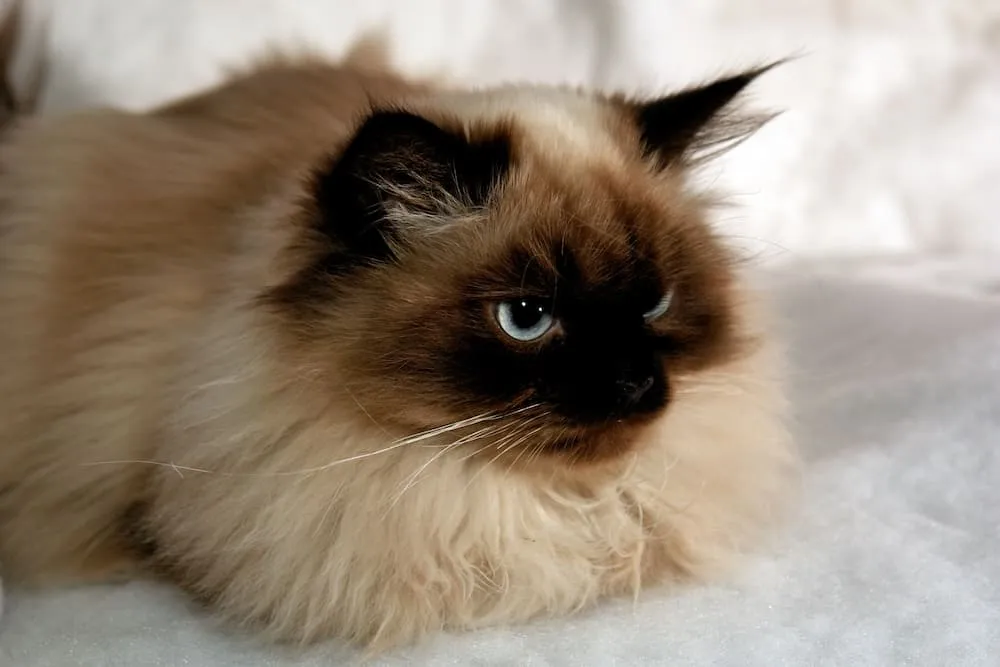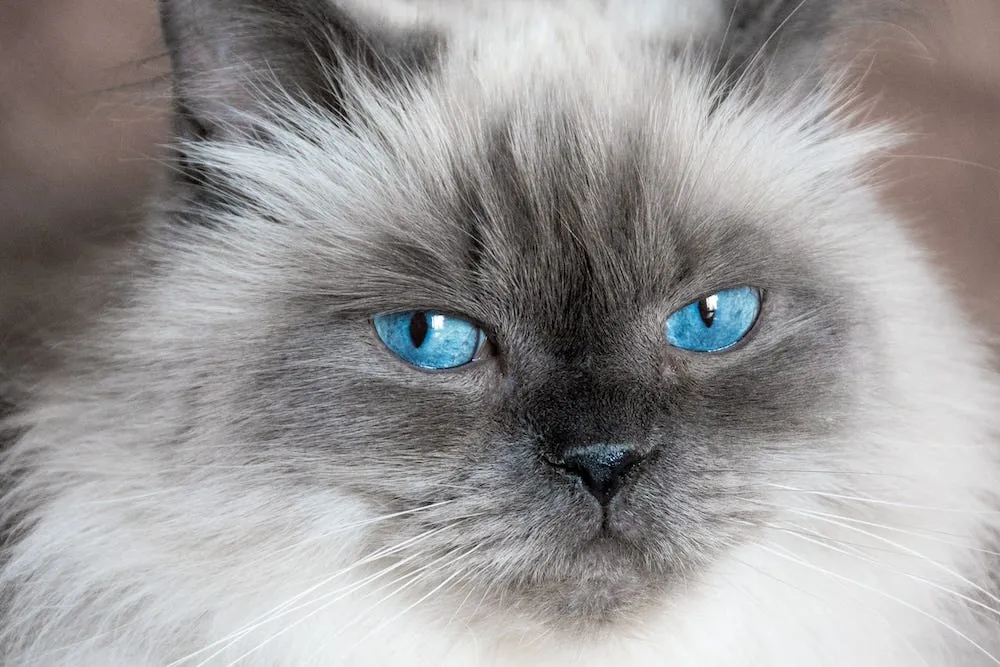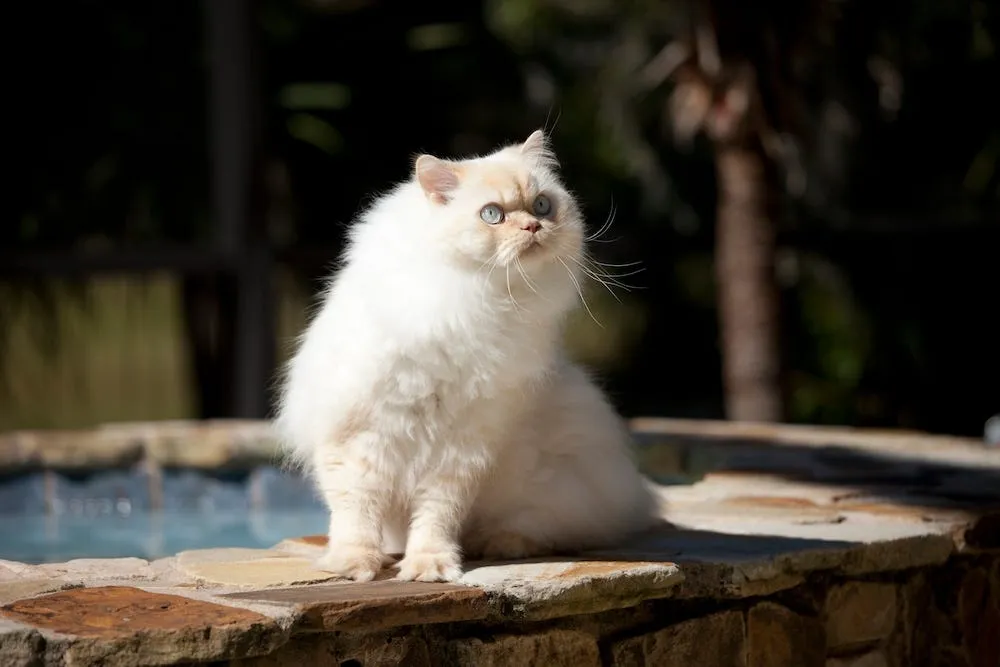The Himalayan cat, with its striking colorpoint coat, flattened face, and famously gentle disposition, is a breed that captures attention. Renowned for being exceptionally laid-back and affectionate, these felines offer a unique companionship. The breed’s development was driven by a desire to combine the luxurious long fur of the Persian with the distinct colorpoint pattern of the Siamese, resulting in a cat of exquisite beauty and a sweet temperament. While 20 coat colors are now recognized by various cat associations, the allure of the Himalayan’s coat is undeniable, often being the initial feature that draws admirers, only for their captivating personalities to solidify the bond.
Origins of the Himalayan Cat
The Himalayan breed emerged in the 1930s through the dedicated efforts of breeders Clyde Keeler and Virginia Cobb. Their goal was to create a cat that possessed both the long, flowing coat characteristic of the Persian and the distinctive colorpoint markings of the Siamese. This was achieved by strategically breeding Siamese and Persian cats. The long-hair gene and the colorpoint pattern are both recessive traits, meaning both parents must carry these genes for them to be expressed in their offspring. Keeler and Cobb’s experiments involved mating a female Siamese with a black Persian male, and a black Persian female with a male Siamese. By carefully selecting kittens from these litters and mating them, they eventually produced cats with the desired combination of long fur and colorpoint patterns. Over time, through persistent breeding efforts, the range of accepted Himalayan colors has expanded, ensuring that these gentle companions can be found in a delightful array of variations.
 A Seal Point Himalayan cat with its characteristic dark brown points and blue eyes.
A Seal Point Himalayan cat with its characteristic dark brown points and blue eyes.
Physical Characteristics of the Himalayan Cat
Himalayan cats are admired for their luxurious long coats and distinctive colorpoint patterns, creating a visually stunning feline. These cats are typically medium to large in size, appearing even grander due to their abundant fur. They possess a robust, big-boned frame, usually weighing between 7 to 14 pounds. It’s worth noting that Himalayans are often considered a “lazier” breed, with a tendency towards a low-energy lifestyle. They enjoy lounging, sunbathing, and relaxing, which can make them prone to weight gain. Therefore, maintaining a healthy weight through regular playtime and portion-controlled meals is crucial.
The breed exhibits a generally rounded appearance, with round heads, faces, and bodies. Similar to Persians, Himalayans have a “snub nose,” which is shorter than that of many other cat breeds. They have a strong, broad chest and thick, sturdy legs, embodying the “gentle giant” description despite their size.
The Himalayan Colorpoint Pattern Explained
The defining characteristic of a Himalayan cat is its specific colorpoint pattern. A purebred Himalayan will exhibit this distinct marking; cats lacking this pattern are unlikely to be true Himalayans. The colorpoint pattern involves a body color that is generally lighter and of a single shade, with minimal shading. The “points” – the face, ears, tail, and paws – are typically darker than the rest of the body. This contrast creates a visually striking effect that is unique to the breed.
A Spectrum of Himalayan Cat Colors
While all Himalayans share the characteristic colorpoint pattern and blue eyes, their coloration can vary widely. This diversity allows enthusiasts to choose a Himalayan that appeals to their aesthetic preferences.
Seal Point
The seal point is perhaps the most iconic and frequently imagined coloring for a Himalayan cat, likely due to its prevalence in the Siamese breed. These cats feature a creamy or pale beige base coat, contrasted by dark brown, almost black points. The nose leather and paw pads are also a deep dark brown, perfectly complementing the points.
Chocolate Point
A chocolate point Himalayan boasts an ivory-colored body with points of a rich milk chocolate hue. Their bright blue eyes stand out beautifully against the darker facial mask. The nose leather and paw pads are a delicate cinnamon-pink, subtly blending into the coloration of their legs and face.
 A Chocolate Point Himalayan cat with its ivory body and milk chocolate points.
A Chocolate Point Himalayan cat with its ivory body and milk chocolate points.
Lilac Point
The lilac point Himalayan is a truly unique and beautiful variety. Their base color is a delicate purple-white, with points of a soft grey-pink. The distinction between body and point color is often less pronounced, and their nose leather and paw pads present as a lavender-pink.
Blue Point
Characterized by a bluish-grey body with cool undertones, the blue point Himalayan has points of a darker blue shade. Their eyes, nose leather, and paw pads are all a striking blue, creating a harmonious cool-toned appearance.
 A Blue Point Himalayan cat with its bluish-grey body and darker blue points.
A Blue Point Himalayan cat with its bluish-grey body and darker blue points.
Red / Flame Point
These Himalayans display a creamy base coat with points of orange or red. The intensity of the red or orange can vary, appearing lighter or darker. Their nose leather and paw pads are a vibrant coral pink.
Cream Point
The body of a cream point Himalayan is a white cream color, with points often described as buff cream. While the distinction isn’t always stark, their nose leather and paw pads are a coral pink. Maintaining a clean litter box is particularly important for white cats, as they tend to show dirt more easily.
 A Cream Point Himalayan cat showing its subtle point coloration.
A Cream Point Himalayan cat showing its subtle point coloration.
Blue-Cream Point
A blue-cream Himalayan features a cream-colored body with a hint of blue, and blue points interspersed with patches of cream. The nose leather and paw pads can range from blue to pink.
Lilac-Cream Point
This variation presents a creamy base coat with lilac points that have patches of cream. Their nose leather and paw pads are a pleasing lavender-pink.
 A Lilac-Cream Point Himalayan cat demonstrating its unique color blend.
A Lilac-Cream Point Himalayan cat demonstrating its unique color blend.
Seal-Tortie Point
These rare cats have a creamy white body with dark brown points that feature unbridled patches of red and cream. Their nose leather and paw pads can be either dark brown or coral pink.
Chocolate-Tortie Point
Chocolate-tortie Himalayans have an ivory-colored body with chocolate points, marked with patches of red and cream. Their nose leather and paw pads are typically cinnamon pink or coral pink.
Himalayan Lynx Patterns: A Striped Variation
The Himalayan lynx pattern is distinguished by the presence of tabby markings, most notably an “M” shape on the forehead, which is echoed in stripes throughout their points. Their bodies, however, remain a solid color. This pattern adds an extra layer of visual complexity and charm to the breed.
Seal Lynx
A seal lynx Himalayan has a beige body with beige-brown points that are ticked with darker brown tabby markings. Their paws are seal-brown, and their nose leather can vary from seal brown to brick red.
Blue Lynx
The body of a blue lynx Himalayan is bluish-white, with points that are a light, almost silvery, blue ticked with darker blue tabby markings. Their paw pads are blue, while their nose leather can be blue or rose-colored.
Red / Flame Lynx
These cats feature a creamy white body with orange points, ticked with red tabby markings. The nose leather and paw pads are coral pink.
Cream Lynx
A cream lynx Himalayan has a white body with cream-colored points that are ticked with darker cream tabby markings. Their nose leather and paw pads are coral pink.
Seal Tortie Lynx
These cats have a creamy-white body with beige-brown points featuring dark brown tabby markings, interspersed with patches of red. Their nose leather and paw pads can be seal-brown, brick red, or coral pink.
Blue-Cream Lynx
The body of a blue-cream lynx Himalayan is bluish-white, with blue points ticked with dark blue tabby markings that also include patches of cream. Their nose leather and paw pads can be blue, rose, or pink.
Chocolate Lynx
A chocolate lynx Himalayan exhibits an ivory body with milk-chocolate points ticked with darker chocolate tabby markings. Their nose leather and paw pads can be cinnamon pink or coral pink.
Lilac Lynx
This variation features a white-purple body with frosty grey points ticked with darker lilac tabby markings. Their nose leather and paw pads are a lavender-pink.
Chocolate-Tortie Lynx
These cats have an ivory body with milk-chocolate points, ticked with darker chocolate tabby markings and patches of red. Their nose leather and paw pads are cinnamon pink or coral pink.
Lilac-Cream Lynx
A lilac-cream lynx Himalayan has a white body with a hint of purple, and points that are pale frosty grey-pink, ticked with darker purple tabby markings that include patches of cream. Their nose leather and paw pads are lavender-pink or coral pink.
Caring for Your Himalayan Cat
The majestic coat of the Himalayan cat requires dedicated care to maintain its beauty and health. Regular and frequent brushing is essential to prevent tangles and keep their luxurious fur in pristine condition. By consistently addressing their grooming needs, providing proper nutrition, and ensuring adequate physical activity, you can expect your Himalayan to remain a cherished companion for many years. Beyond their stunning appearance, Himalayan cats are celebrated for their kind, gentle, and deeply affectionate nature, making them truly wonderful additions to any family.
